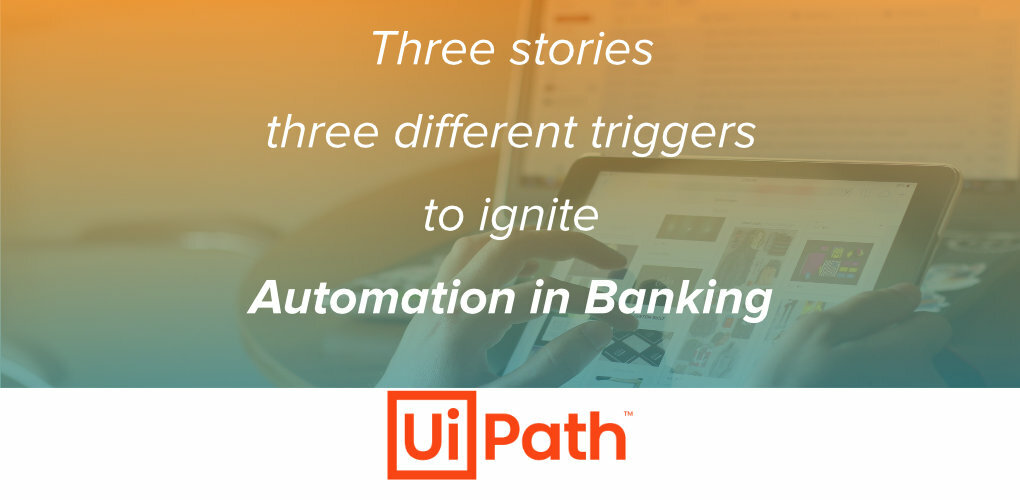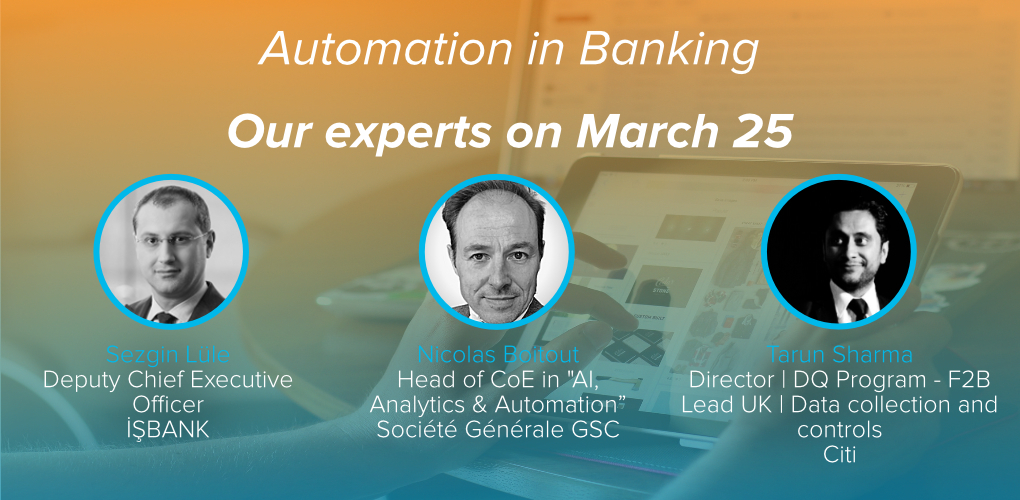
Insights & Opinions
Three stories, three different triggers to ignite automation in banking
Tue, 06 Apr 2021


On March 25, we invited three executives with different backgrounds to share their "Automation in Banking" experience.
The experts were:
- Sezgin Lüle, Deputy Chief Executive Officer, İşbank
- Nicolas Boitout, Head of CoE in "AI, Analytics & Automation” at Société Générale GSC
- Tarun Sharma, Director | DQ Program - F2B Lead UK | Data collection and controls, Citi
The input we got from them was so valuable that we decided to share the insights over two pieces of content. In this blog, we discuss these three people's journeys when implementing automation in their organisation and the value they gained from these journeys.

Build scale, agility and employee satisfaction
The first story is the one by Sezgin Lüle, Deputy CEO at İşbank. İşbank is the biggest private bank in Turkey, an enormous market with a highly digitised banking culture. They started with RPA back in 2017 in their operation centres, the departments dominated by repetitive tasks that were taken care of by 1.500 people.
They gradually expanded to branch processes and processes in headquarters. Today they have almost 70 robots deployed that do the work of an equivalent of 300 FTEs. People who were impacted found the time to reskill and look for more rewarding jobs.
Today RPA and automation are accepted across the organisation. Besides efficiency, Sezgin sees a more substantial change that happened as a result of RPA: "It brings a cultural change into the organisation because when you look at the benefits of automation, the RPA implementation enables the organisation with quick implementations. The ease of implementation suddenly brings business impact."
RPA development doesn't require technical coding, and a well-trained business person builds robots without being dependent on slow ICT release cycles. Of course, this requires a reskill of (part of) the organisation, so make sure to build the first quick wins, free time of people to train and roll it out across the organisation.
Sezgin: "We still have 1500 people on our course. In İşbank, we have this strategy to make people fulfil their potential. So we use technology, not instead of people, we use technology to augment their capabilities so that they can learn new stuff, new skills, and they can do more rewarding activities."
Improve efficiency and data accuracy in central functions
Nicolas Boitout, Head of Centre of Excellence in AI, Analytics and Automation, of Société Générale Global Solution Centre Romania, was our second expert. The first experiences with RPA at Society Générale date back to 2015-2016, in Bangalore, one of their Centre of Excellence bases. The idea that IU (user interfaces) were created to replace human clicks and fill in and capture forms. This was a very appealing approach because it felt very intuitive.
They started with the bank's central functions without touching the core banking business itself: HR, finance, compliance, marketing.
This experience made them dream of the next steps. However, the first generation RPA, based on UI, could not fulfil its promise. They remained dependent on IT for setting up these robots and maintaining them. That was complicated, given the interference with the core banking platform.
Nicolas: "The IT of the investment bank said that they wanted to disengage, what they had created already back in 2017, at least 100 bots that were in production and up and running. And they started to disengage progressively from this RPF first generation."
"We started to scale down and move some of the automation that we are doing through a user interface to APIs", explained Nicolas. " We have more than 4000 APIs. So this ability to connect between applications was done through this protocol instead of going through a user interface."
Going further, Nicolas sees a lot of potential in low-code applications, allowing business to take control over their robots without impacting IT too much. Of course, they keep following up closely on how the RPA industry evolves going forward.
Improve control and audit mechanisms
Tarun Sharma, Director DQ Program - F2B Lead UK of Data collection and controls at Citi, had a completely different story on why he's so passionate about automation. He started in this position a few days before the event, so the experience he shared was based on prior working experiences.
In the past, he also worked a General Electric before. Perhaps that explains his different views on automation in banking. Tarun: "We started realising the biggest problem we had, was looking at a different angle: controls. Most of the controls and how they run in various departments of a bank were looked at through manual checking, whether it's an external auditor, internal auditor, a compliance officer, first line, second line, team leader checking certain".
With a multitude of technologies, they started investigating how automation could help, not just to detect exceptions but also to overcome them. They looked at robotics, analytics, workflow management, visualisation, etc., to detect exceptions, solve them, and add control mechanisms to detect and avoid them in the future.
Tarun: "Until 2015, everybody was saying, what are your controls? And they were happy with it. Then the next question they would ask was: show me your controls? They were happy once you show them the controls. But now the question in 2015 started becoming proof your controls work. The approach which regulators are taking now is to ask the data so they can build their own reports".
Their automation projects were to prove to the regulator that it is truly an exception, and to prove the point, they fixed it. To achieve this, they build on a combination of automation, analytics and process redesign.
Tarun explained: "We picked up a massive process looking at our general ledger, looking at our contact database. And then finally, looking at our booking systems. That data alone is enormous. If you're given simple automation software, that will break. We had to bring in analytical, big data software, put it all together, apply robotics and a visualisation technique and say, "this is the hotspot". We looked at automation differently."
As always, there is a clear positive business case in this approach, but the initial trigger was not so much to cut FTEs but to improve processes and facilitate one-click controls for regulators, audit, management etc.
Conclusion
These three stories on automation in banking, with each another approach and another end-goal. It is inspirational to see how all this looks in practice. Because the rules of the game are quite general, we also saw non-bankers eager to join this session.
Next week, we share a second blog on this session with more insights on how our speakers and the audience looked at intelligent automation, hyperautomation and a few lessons to help you skyrocket your automation projects.
Make sure you free your agenda on September 9th, when we welcome Chris Skinner, author and commentator at The Finanser and Nitin Purwar, Director Banking Industry Practice at UiPath to discuss "Automation for Good: Automation as an enabler for ESG and Sustainability in Banks."




